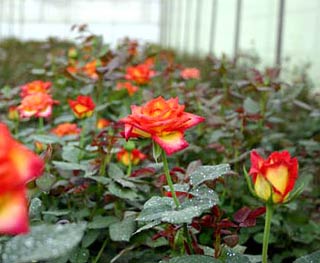Human Flower Project
Tuesday, March 27, 2007
Short-Cut Economics: Uganda’s Flowers
Flower firms in Uganda are close to gaining big tax-incentives for their industry, but who’ll really benefit?

Roses grown for export on a Uganda farm
Photo: M. Herricks/Chemonics
Flower exports from Uganda have been gaining strength over the last dozen years. “The climate conditions around Lake Victoria suit the production of sweetheart and intermediate roses,” writes FlowerTech. Farther west, at higher altitudes, the larger, pricier roses grow well, too. Exports grew at an annual average of 25% for seven years. In 2005, there were 22 flower firms here with combined foreign exchange earnings of $35 million U.S dollars.
But recently, Uganda’s flower fortunes have been backsliding. Blame the weather. Blame the high cost of freight. Or, as the nation’s flower firm leaders are wont to do, blame the Ugandan government for failing to meet or exceed the financial breaks that other African nations have given their own flower companies.
Back in 2005, Uganda’s growers voiced alarm as they saw Ethiopia’s government stepping up efforts to attract flower businesses—sponsoring guided tours for Dutch investors, promising easy contracts and ready utilities, as well as generous “tax-holidays.” With harder times for Uganda’s growers, pleas for federal help have increased, and it now looks as if the government will comply.
“This week, President Yoweri Museveni told the growers during a meeting at State House in Nakasero that the issue was resolved and the government would grant them full incentives by July.”
The Uganda Flower Exporters Association has asked for “a 10-year tax holiday, a duty-free tax holiday for capital equipment, raw materials and other resources, and exemptions from withholding tax, value added tax and stamp duty.” Quite a hefty subsidy, and one that about matches neighboring Kenya’s arrangement.
Predictions? “The new package is expected to boost the industry’s annual earnings by 80 million dollars in two years. The sector will expand to 600 hectares from 210 by encouraging new investments and more people to invest in high-altitude rose- growing. It will also employ 20,000 people from the current 6,000.”
(Some other promising news, under an agreement reached last July between the National Union of Plantation and Agricultural Workers and the Uganda Flower Exporters Association, flower workers have been able legally to organize. And last month, they did so. Workers at Rosebud, one of Uganda’s biggest flower farms, formed a union.)
 Workers at Uganda’s Fresh Handling Ltd.
Workers at Uganda’s Fresh Handling Ltd.
hustle flowers through cold storage
Photo: DGL Felo, via USAID
The new boost for Uganda’s flower industry all sounds so lucrative, so legislated-for-success, one wonders why it didn’t happen sooner. But that’s because no one ever prices out the opportunities lost under such schemes. What if Uganda had decided to put investments of the same scale into health care, into education? Would more people realize a greater benefit? Who owns these Ugandan farms and export firms? Will the big winners in this arrangement be the people of Uganda or investors from abroad?
Government incentives that support low-wage, low-tech industries should always get BS-detectors clicking. Take the example, writer Bill Bishop suggests, of Mississippi in the 1930s. Its state government decided to invest in low wage industries like lumber. And look at the result. Rural Mississippi is now one of the poorest and worst educated regions of the U.S.
“We need to match the incentives that Kenya and Ethiopia have put in place if we are to compete,” stressed Juliet Musoke, of the Uganda Flower Exporters Association. But, Ms. Musoke, you may have entered the Great International Mississippi Look-Alike Contest.




